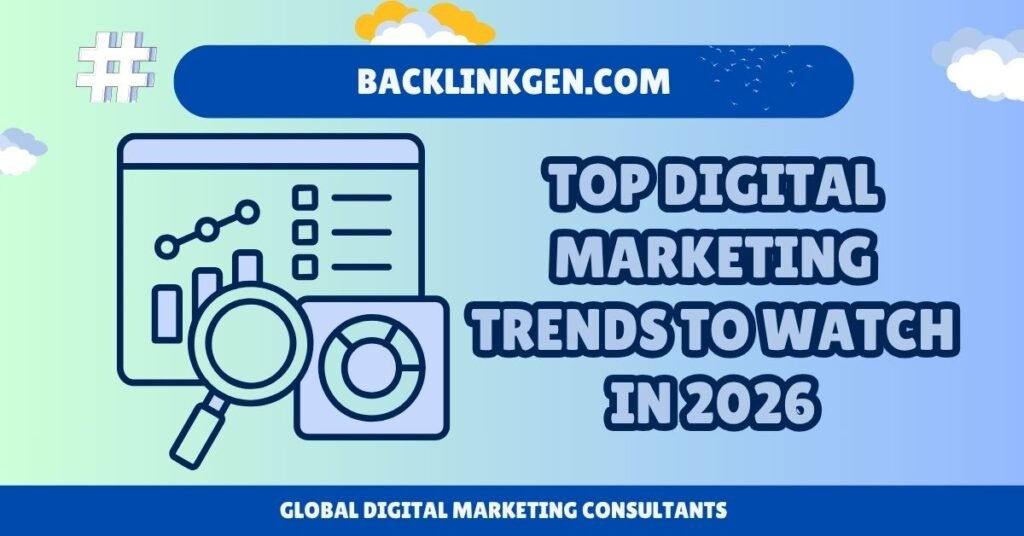By Amit – Senior Digital Marketing Consultant
Digital marketing continues to evolve faster than most brands can keep up. Algorithms, automation, and audience behaviors are changing at a pace that demands constant adaptation. As someone who manages SEO, paid campaigns, and social media for diverse clients — from a CRM SaaS firm to multiple schools and colleges — I can confidently say that 2026 will be the year of smarter, data-driven, and more personalized marketing.
In this blog, I’ll cover the top digital marketing trends for 2026, explain how they’re shaping the industry, and what brands can do to stay ahead.
1. AI-Powered Content and Campaign Optimization
Artificial Intelligence isn’t just a buzzword anymore — it’s the foundation of marketing in 2026. From ad optimization to predictive analytics, AI is transforming every channel.
- What’s new in 2026: AI is now capable of generating hyper-personalized ad copy, optimizing budgets in real-time, and predicting the best channels for audience engagement.
- Tools like ChatGPT, Jasper, and Copy.ai help marketers generate contextual, SEO-optimized content quickly.
- AI tools like Albert.ai or Smartly.io automate entire ad campaigns across Google and Meta, analyzing millions of data points instantly.
👉 My advice: Use AI to handle repetitive marketing tasks — but keep your human creativity for brand storytelling and emotion-driven campaigns.
2. Voice Search and Conversational Marketing
With the rise of smart speakers, voice assistants, and voice-enabled devices, voice search optimization will be critical in 2026.
- 70% of households globally are projected to use a voice assistant by 2026.
- Search phrases are becoming more natural and conversational, e.g., “best digital marketing agency near me” instead of “digital marketing agency.”
Brands need to adapt content for long-tail, question-based keywords and optimize FAQs for voice snippets.
👉 Real-world example: When optimizing school websites, I include Q&A sections like “What are the best schools for Class 11 admission in Lucknow?” — this directly targets voice queries.
3. Video Marketing Dominance (Especially Short-Form)
Video continues to outperform all other formats. Platforms like YouTube Shorts, Instagram Reels, and TikTok dominate consumer attention.
In 2026, expect AI-edited, data-driven video storytelling — brands will use predictive data to understand what visuals, tones, and hooks perform best.
- Educational brands can leverage micro-explainers or virtual campus tours.
- SaaS companies should create 30-second “problem-solution” clips to attract decision-makers.
👉 Pro tip: Always include captions and strong CTAs at the end of every video to increase retention and conversion.
4. Privacy-First Marketing and Cookieless Tracking
As Google fully phases out third-party cookies by 2026, marketers must focus on first-party data and consent-driven personalization.
- Expect stricter data laws and more transparency demands from users.
- Tools like GA4, Segment, and CDPs (Customer Data Platforms) will help track user journeys ethically.
👉 Amit’s insight: For schools and colleges, I now focus on building email lists through gated content (e.g., downloadable brochures or guides) rather than relying solely on pixel data.
5. The Rise of Search Beyond Google
Search is becoming multiplatform — users are searching on YouTube, TikTok, Amazon, and even ChatGPT-like assistants.
- For younger audiences, TikTok is replacing Google as their primary search engine.
- Brands must now optimize content for platform-native search behavior.
👉 Strategy tip: For a CRM SaaS client, I’ve started optimizing short explainer videos with searchable keywords on YouTube — not just web blogs.
6. Humanized and Authentic Branding
In a world flooded by automation, authenticity is the biggest differentiator.
Audiences are tired of over-polished corporate content. They want real people, real experiences, and genuine stories.
- Brands that show vulnerability, behind-the-scenes moments, or user-generated content (UGC) perform better.
- For schools, sharing student success stories and daily activities builds emotional connection.
👉 Amit’s perspective: The future belongs to brands that speak like humans, not corporations.
7. Interactive and Immersive Experiences (AR/VR)
Augmented and Virtual Reality are moving beyond gaming into mainstream marketing.
By 2026:
- E-commerce brands will use AR for virtual try-ons.
- Educational institutions will use VR for virtual campus tours.
- Real estate and travel sectors will adopt immersive walkthroughs.
👉 Implementation tip: Even simple AR filters or 360° videos can drastically boost engagement and brand recall.
8. Predictive Analytics and Data-Driven Decision Making
Data will remain marketing’s backbone — but 2026 is all about predictive analytics.
AI-driven analytics tools can now forecast:
- Which leads are most likely to convert.
- What time of day campaigns perform best.
- Which content will resonate most with a specific audience segment.
👉 Amit’s take: I’ve used predictive dashboards for a college client to identify which campaigns attract high-quality inquiries — then redirected ad budgets accordingly.
9. Influencer Marketing Evolves into “Community-Led Marketing”
Influencer marketing is maturing. In 2026, it’s less about big names and more about micro and nano-influencers who build genuine community trust.
- Micro-influencers have engagement rates 3x higher than large influencers.
- Brands will focus on long-term collaborations, not one-off posts.
- Social commerce integrations (Instagram Checkout, YouTube Shopping) will continue to expand.
👉 Pro tip: For local schools or colleges, collaborating with regional creators or educators yields far better ROI than celebrity endorsements.
10. Automation and Smart Campaign Scaling
Marketing automation will go beyond email — extending into cross-platform orchestration.
Tools like HubSpot, ActiveCampaign, and Salesforce Marketing Cloud will enable unified journeys where a user’s action in one channel triggers tailored messages in others.
- Example: A student downloads a college brochure (trigger) → receives an automated email → then sees a follow-up Facebook ad.
👉 Amit’s insight: Automation saves time and ensures leads don’t fall through the cracks — especially when managing multiple institutions.
11. Sustainability and Ethical Marketing
Modern consumers expect brands to stand for something meaningful. Sustainability isn’t a trend; it’s a requirement.
In 2026:
- Consumers will favor brands with transparent sustainability reporting.
- Campaigns promoting eco-conscious practices will see higher engagement.
- Brands must ensure green claims are authentic — not “greenwashing.”
👉 Example: Education brands promoting “paperless admissions” or SaaS firms supporting “carbon-neutral hosting” resonate deeply with global audiences.
12. Rise of Hyperlocal Marketing
Even in the global era, local targeting remains powerful.
Hyperlocal marketing focuses on connecting with nearby audiences through:
- Geo-targeted ads.
- Local SEO optimization (Google My Business, reviews).
- Regional content and language adaptation.
👉 Real-world use: Running local ad sets for each school’s district instead of one national campaign improved CTR by 40%.
13. Email Marketing Reinvented with AI and Personalization
Email is far from dead — it’s evolving with AI-driven personalization and predictive delivery.
- Tools now send emails at the exact time each user is most likely to open.
- Dynamic content allows different sections of the same email to appear based on recipient behavior.
👉 My advice: Don’t blast — personalize. Tailored newsletters build long-term trust and conversions.
14. The Shift Toward First-Party Data and Owned Media
Since third-party cookies are gone, brands must focus on owned assets — websites, blogs, email lists, and apps.
- First-party data (collected via your own channels) becomes gold for retargeting and personalization.
- Tools like HubSpot, Pipedrive, and Zoho CRM integrate seamlessly for data collection and campaign management.
👉 Example: For schools, I use gated webinars (“How to Choose the Right College”) to build first-party email lists and retarget audiences ethically.
15. The Integration of CDPs and Marketing Intelligence
By 2026, Customer Data Platforms (CDPs) will become the center of marketing intelligence — integrating with CRMs, ad platforms, and email tools.
They’ll enable real-time audience segmentation, unified reporting, and personalized experience delivery across every channel.
👉 Amit’s tip: Any growing business — especially in education or SaaS — should invest in a CDP early to unify fragmented marketing data.
Conclusion: Marketing in 2026 Will Be Human + Data-Driven
As we move into 2026, marketing success won’t depend on how many tools you use — but how well you connect data, creativity, and authenticity.
AI will handle the automation. CDPs will unify your data. Predictive analytics will guide your next steps.
But the human element — storytelling, empathy, and emotional resonance — will remain irreplaceable.
For marketers, agencies, and businesses alike, 2026 is the time to blend technology with humanity. The brands that succeed won’t be those shouting the loudest — but those listening the closest.

